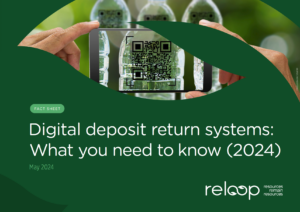As of May 2024, 56 deposit return systems (DRS) are operational worldwide, serving over 346 million people. With jurisdictions such as Austria, Poland, Turkey, Uruguay, and Singapore expected to implement new systems in the next few years, the adoption of this policy tool shows no signs of slowing down. Amidst this global surge in deposit return legislation, some stakeholders have turned their attention to a unique variant known as digital DRS (DDRS), also called serialised DRS.
Unlike classic DRS, where consumers pay a deposit upfront and return empty containers to designated locations for refunds, DDRS utilises smartphone apps for scanning empty containers, which are then placed into existing kerbside recycling bins. Aside from the key difference in return pathways, the concept of DDRS relies on the use of serialised unique barcodes or QR codes to identify each container within the system.
While there is some interest in implementing DDRS by certain stakeholder groups, it’s important for policymakers to understand the differences between classic DRS and initiatives primarily focused on rewards or incentives for demonstration purposes. It’s also crucial to recognise that the complexity of a classic DRS extends beyond a simple rewards-based system and requires extensive, intricate, and sophisticated infrastructure to effectively manage substantial financial transactions (that is, large amounts of money) across the system in an equitable manner. Although many producers may be willing to finance small-scale, one-off pilot projects involving small cash rewards or other incentives, they may be reluctant to assume broader environmental and social responsibilities when faced with the prospect of funding a large-scale DRS.
Our latest fact sheet
“Digital deposit return systems: What you need to know (2024)” – the third in our DDRS fact sheet series – is designed to be a valuable resource for policymakers, industry stakeholders, and anyone interested in the evolving landscape of digital (serialised) deposit systems. In addition to presenting the latest developments in DDRS research, the fact sheet provides a summary of DDRS trials that have been conducted including a comparative analysis.
-

Digital deposit return systems: What you need to know
Overview of new digital elements that are included within the concept of digital deposit return systems (DDRS).
Classic DRS and DDRS: What’s the difference?
Classic Deposit Return System (DRS)
| How is the system financed? | In best practice DRSs, the system is financed through a combination of unredeemed deposits, material revenues, and eco-modulated producer fees. |
| How are containers collected? | In best practice DRSs, retailers who sell beverages are legally obligated to provide take-back services and refund the deposit. Return-to-retail (R2R) models offer the most convenience for consumers, allowing them to return containers during shopping (or, if they are consuming their beverage outside of the home, to the nearest convenient location, which may be a shop or other local hub). |
| Quality of material collected? | High-performing DRSs based on best-practice principles are known for their ability to collect high quantities of beverage containers and maintain the materials’ high quality in a way that enables closed-loop applications like “bottle-to-bottle recycling”. This is because beverage containers are collected separately from other packaging materials (e.g., dirty food containers), which minimises contamination. |
| Impact on litter reduction? | Attaching a monetary value to beverage containers, in the form of a refundable deposit, decreases the likelihood that containers will be littered or remain as litter in the environment. |
| Does the system facilitate the transition to refillables? | Yes, DRSs serve as a mechanism to promote the adoption of refillable beverage containers by encouraging consumers to return containers and the establishment of necessary infrastructure. With modern DRSs, the consumer does not have to distinguish between returning a container for recycling or reuse; that distinction is made instead by the back-end handling systems. |
DDRS and Rewards-based Alternatives
| How is the system financed? | DDRS and rewards-based alternative systems are often financed through a combination of sponsorship from industry stakeholders, or government subsidies. |
| How are containers collected? | DDRS assumes that the existing municipal waste management infrastructure will absorb and manage in-scope material in a dedicated stream, as part of the household waste. This would likely require infrastructure repurposing and upgrades that have not yet been explained or costed in detail. |
| Quality of material collected? | RFID-enabled bins and other “smart” containers offer no control on contamination. Although a smart bin might be less contaminated than a regular waste or recycling bin, there is no guarantee of improved material quality, as consumers could discard any type of litter into the bin. It is also unlikely that PET collected through commingled containers would be of food-grade quality. |
| Impact on litter reduction? | Unlike a classic DRS, which requires containers to be physically returned to designated points to obtain the deposit refund, a DDRS allows individuals to simply remove or photograph the code to redeem the reward/incentive value. As a result, littered containers are less likely to be picked up and properly recycled, as the focus shifts from returning the container to merely scanning the code. |
| Does the system facilitate the transition to refillables? | No, contamination in municipal bins, lack of a system for acquiring and washing reusable containers, and unclear ownership and responsibility for selling collected material, all hinder beverage container reuse. |